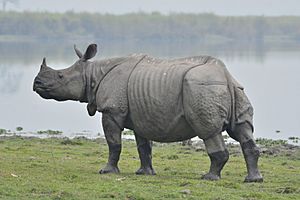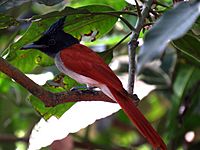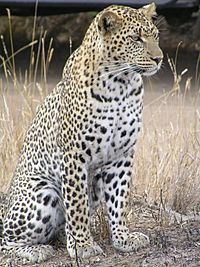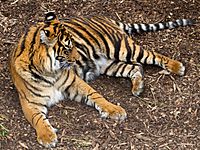Subspecies facts for kids
A subspecies is a group of animals or plants that is a step below a species in how scientists classify living things (taxonomy). Think of it like a smaller family within a bigger family. When you see a scientific name with three parts, the third part tells you it's a subspecies. For example, Canis lupus familiaris is the domestic dog, and Canis lupus is the wolf. The "familiaris" part shows it's a subspecies of wolf.
One cool thing about subspecies is that animals or plants from different subspecies can often have babies together. This is usually not possible for animals from different species. Scientists can tell subspecies apart by looking at their appearance or by checking their DNA.
Sometimes, you might find groups of animals that seem to be in between two subspecies. This happens because evolution is a slow, continuous process, and changes don't always happen in neat steps. In botany (the study of plants), you might see "subsp" or "ssp" before the third part of a plant's name to show it's a subspecies.
Contents
Examples of Subspecies
Here are some well-known examples of subspecies:
- The dog (Canis lupus familiaris) and the dingo (Canis lupus dingo) are both subspecies of the wolf (Canis lupus).
- The domestic cat (Felis silvestris catus) is a subspecies of the wild cat (Felis silvestris).
The "Original" Subspecies
In zoology (the study of animals), when scientists divide a species into different subspecies, the very first group they describe is called the "nominate subspecies." This subspecies gets to keep the same name as the main species.
For example, the Russell's Viper is a snake with the scientific name Daboia russelii. The "Indian Russell's Viper" is the nominate subspecies, and its full name is Daboia russelii russelii. You can see how the species name "russelii" is repeated for the subspecies.
Species with One or Many Subspecies

Scientists also talk about species being "monotypic" or "polytypic."
- A monotypic species is one that does not have any subspecies. It means all the individuals of that species are pretty much the same everywhere they live. The Indian rhinoceros (Rhinoceros unicornis) is an example of a monotypic species.
- A polytypic species, on the other hand, has two or more different subspecies. These subspecies might look different or have different DNA. They usually live in different areas and don't breed with each other in the wild because they are separated. However, if they were brought together, they could still have fertile offspring. Zoologists, botanists, and microbiologists are the scientists who describe and name these distinct groups.
Images for kids
-
Panthera tigris tigris is the Bengal tiger, found in the Indian subcontinent. This is the nominate subspecies of the tiger.
-
Panthera tigris altaica is the Siberian tiger, another subspecies of tiger.
-
Panthera leo persica is the Asiatic lion, the only subspecies of lion found in Asia.
-
Acinonyx jubatus jubatus is the South African cheetah, the nominate subspecies of cheetah.
See also
 In Spanish: Subespecie para niños
In Spanish: Subespecie para niños








